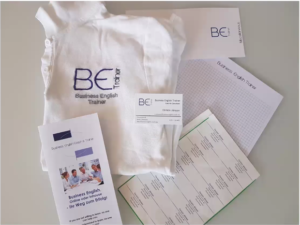Many ESL professionals are passionate about the work they do – much less so about marketing themselves. At the last Inter ELTA Day, experienced solopreneur Christin Jönsson spilled the tea about effective and authentic personal branding. The good news: it’s not rocket science and it doesn’t have to be expensive.
In her talk, Christin started off by pointing out the obvious: you’re a passionate ESL teacher or trainer, but selling yourself isn’t something you care about in a big way. Because all you want is do a great job and make your clients happy.
Still, as a freelancer, you’re most likely a small fish in a big sea. What you do isn’t monumentally different from what your colleagues do – and that’s OK, of course. Nobody is expected to re-invent the ELT wheel.
However, this means that how you package your offer could be important if you want to be noticed and find work in a consistent manner.
How branding can help both you and your clients
As a solopreneur, having your own brand can go a long way towards attracting and building fruitful relationships with your clients. Here’s why:
A good brand will stand out and convey a message of professionalism and trust.
Authentic branding shows that you care and put in the hard work to make your business presentable. So in the mind of the customer, your offer will naturally look more attractive and, indeed, valuable. Just like beautiful wrapping paper makes a nice gift look even more precious.
In short, a good brand will stand out and convey a message of professionalism and trust. This will help your clients feel that they are making a good choice working with you. As a result, the collaboration will be more pleasant and successful.
Before building your brand, there are some things to consider: if your offer doesn’t speak to your target audience, your service may be overlooked. Also, if you are too vague about your values, you may attract the wrong clients.
Therefore, Christin recommended asking yourself the following questions:
- Who is my target audience?
- What exactly do I offer?
- What are the values that I’d like to represent?
As an example: your target audience could be international NGO representatives, your offer could be intercultural communication for the not-for-profit sector and your values could be building trust to foster cooperation and facilitate win-win-solutions.
To sum up, your brand reflects what you offer to whom and in what spirit.
So once you are clear about these key factors, what else do you need to build a brand that shines?
Little tweaks, BIG difference
Here are some tips from Christin that you can start implementing right away to increase professional credibility:
- Having a professional email address (a no-brainer, really. For business purposes, your email address should contain your name or the name of your brand and have a recognizable ending, such as .com or .org). To make the most of it, add more information about your business (links, logos…) to your email signature.
- The name of your business. You don’t have to cook up something fancy, but it should feel authentic to you and relate to what you do.
- Create something that represents your business visually. Most of us are visual beings, so having a visual anchor, such as a logo, will make a more memorable impression. You can put it on everything you use, so your clients will spot your brand at a glance.
- Having your own website. OK, this is more than just a little tweak. But actually, it’s not as intimidating as it sounds. With all the inexpensive options and services out there, you can easily have your own landing page set up.
- Little giveaways. Apart from promo materials such as brochures or business cards, think about everyday items, such as notepads, pens, calendars…just see to it that they are of good quality, because they represent your brand.
A closer look at the visuals: Logos, fonts and colors
A picture is worth a 1000 words… so while not manadatory, a logo is definitely nice to have. Potential clients will remember your brand and connect the dots of who you are and what you do at a glance.
A logo works best if it meets the following criteria:
- it’s recognizable (simple and clear)
- it has personality
- it stands out from competitors
You can either buy a logo or use one of the free logo design makers out there (just beware of hidden charges). This can be a fun and creative DIY project – try out different icons, colors, fonts and shapes. Alternatively, just get the logo and pick your own colors and fonts with the help of Powerpoint and Microsoft Office. Fonts and colors matter, because they add aesthetics and meaning.
The font you pick must be free for commercial use, such as the Steiner font, which is also specifically designed for logos. You can just download and preview fonts at wordmark.it.
As your brand develops, tweak your logo from time to time to make sure it still represents you.
If you want, modifiy your logo and use different variants of it for different purposes.
Using images
Images are something you might want to use for your promo materials, such as flyers or brochures. To be on the safe side legally, you can buy stock photos from sites such as depositphotos.com or Shutterstock. If you have them done by a photographer, make sure you have the commercial rights. Of course, you can also use your own images.
For best quality, always make sure to get a big photo and adjust the size if necessary (if you try to enlarge a small image, it can easily become blurry).

Having your own website
Having your own landing page is a slightly bigger project than building a logo. However, with platforms like Squarespace or Wix you can set up your own page without coding skills – it’s basically copy and paste. Alternatively, you can pay a freelancer on Upwork to take care of your website.
If you live and work in Germany, please note that your website has to come with a legal notice and privacy statement (a well-versed freelancer should be able to get this done for you). Also, you will need to register as a small entrepreneur (“Kleinunternehmer”) at the chamber of commerce because your website serves a commercial purpose.
If this sounds overwhelming and you don’t want your own website (yet), a telling LinkedIn-profile and a digital business card are a solid alternative.
Last but not least: Tell a story
The last tip Christin had in store was the one about storytelling.
If you want to be remembered by the people you meet at events and conferences, witty banter and stories are the way to go. The reason for this is, again, that there are lots of people out there doing what you do.
That’s why telling a little story works so much better than just stating the facts.
To give you an example, here are two answers to the frequently asked question “What do you do?”
A: “I’m a business English trainer.”
B: “I help people make themselves heard in international business settings.”
Which of the two sounds more intriguing to you, and who would you rather chat to and have (virtual) lunch with?
While both replies are valid, the second one evokes much stronger images – you can almost see the clients at a fancy dinner table, discussing business matters.
Moreover, the second answer isn’t about a generic service (boring), but about solving a specific problem (interesting).
So the next time somebody asks you about your job, instead of giving a predictable answer try to describe what you do in one or two sentences (alternatively, try adding a sassy little tagline to your online profile and business card).
Final thoughts on authentic branding
While setting up your own personal brand may seem like a mammoth project, the info that Christin shared at the Inter ELTA day can help you get started in an easy way, and at (almost) no cost.
Do you actually need your own brand if you already have a good network, social media profile and references? Of course not – if it works, it works.
But if you feel that you’d like to try personal branding, you can implement some of the tips from the article. Whether it’s creating your own digital business card, designing a logo or thinking of a little story to tell about yourself.
Sandra is ELTABB's Chair and the current editor of the ELTABB journal. She holds an MA in English and is passionate about brain-friendly language learning and teaching. Likes Shakespeare and Venetian lute music.







